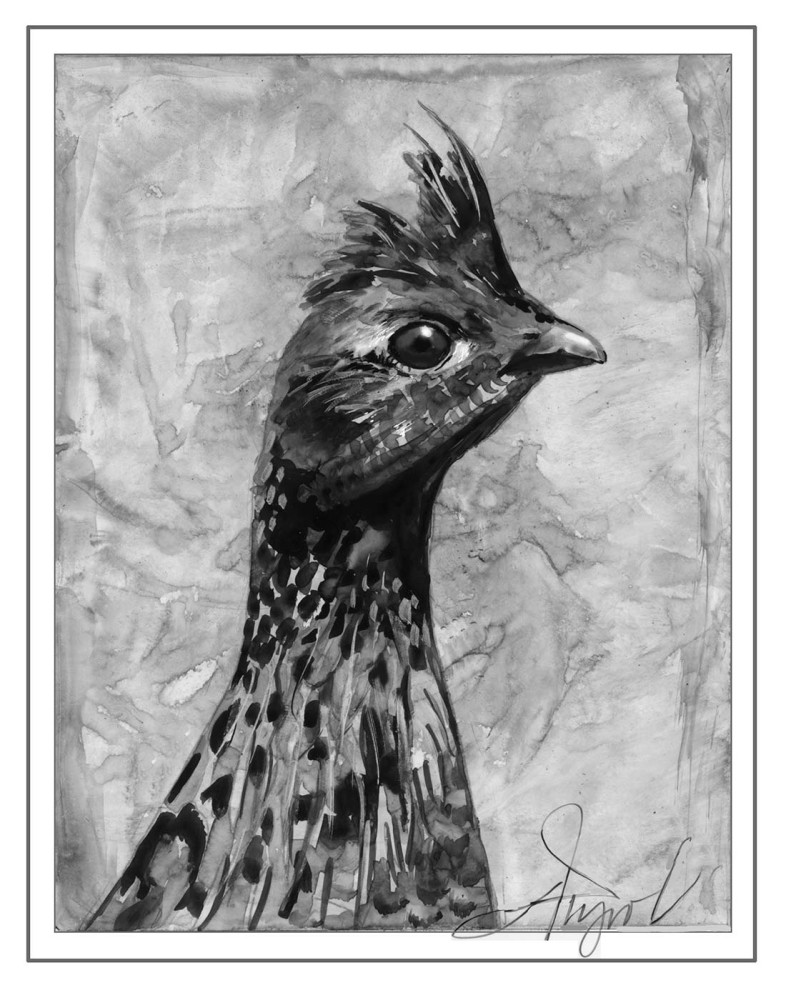
A few weeks ago, I noticed a dark, football-shaped shadow skulking quietly among the stems of honeysuckle and lilac by our driveway. I was throwing seeds to the blue jays that wait for it in the morning, and I tossed a handful into the border for the stranger in the shadows. Out popped the head and neck of a ruffed grouse. She took a few steps towards me, stopped, and began filling her crop, an expandable pouch near her throat useful for storing food the bird will digest later. This took a few minutes and then it was back under cover for our unusual visitor.
Ruffed grouse – named for their long, chocolate-colored, light-edged neck feathers – generally live an elusive and solitary life. Male and female grouse look much the same, with males typically slightly larger than females. During courtship displays, the male mounts a fallen log and rapidly beats its wings against the air to create a low, drumming sound. Simultaneously, the bird extends its ruff and fans its tail to grow in apparent size and vitality. We hear them drumming in the spring, but if we see grouse at all, it’s generally a blur on the wing.
Grouse are members of an order and family – Galliformes and Phasianidae – that includes turkey, pheasants, and most quail species. Gallinaceous birds are the group from which our domesticated chickens, fowl, and turkey come from. Obviously, the grouse in our yard had found an abundant and easy food source and became quickly habituated. By the third day, she was coming to our feet to feed. Unperturbed by human activity, she allowed us a rare close-up view.
Ruffed grouse may be mainly red-brown or gray in color. Ours was a lovely reddish-brown, painted in hues from tawny and tan to pale yellow and amber. From our vantage of two feet away, we could see the finest feathers of the head, including the pen-line thin decorations below the eye, the pale-yellow bib under the chin that gives way to the delicate horizontal lines, and the tawny line through the eye. Her breast and sides were adorned with horizontal white and dark barring. This cryptic coloration allows her to blend in with the leaves and shadows of the forest floor.
One morning, at 8 degrees below zero, we found the grouse standing on the concrete knee-wall by our back door. She churred softly, tuk’tuked, then filled her crop with seed. Her food in the wild would be less seed and more flower and leaf bud of birch, cherry, and aspen, and the catkins of hazels. Back on her perch in the snow, her body contour feathers rose, neck to belly. She became a feathered football. Her body lowered onto her feet, then her head sank into her neck. Now she was impervious to the cold, the heat-trapping spaces between her contour feathers and downy feathers doing their work: even a thin layer of feather-trapped air can maintain bird’s body temperature at around 104 degrees.
Grouse spend much of the winter buried in snow, which provides both insulation and safe cover. Many a woods-skier and snowshoer has been startled by a grouse exiting its snow roost in a sudden burst of feathers and flapping wings. Typically, they dive under the snow headfirst, then hollow out a cavity and settle in for the night. The grouse in our yard, however, used a different roosting tactic. Late one morning, she made her way down the fresh snow along the edge of the drive. She stopped, turned, and slowly began to settle, moving her body this way and that, using her feet and wings until her belly was under the snow, then her shoulders, and finally her head, retracted like a feathered periscope.
Our grouse guest has stopped by regularly for several weeks now. We aren’t far from the natural woodland haunts of these birds, and other homes with feeders are closer still. So I’m curious about what first brought this bird out of her natural habitat to our driveway. Whatever her reasons, we’ve enjoyed her presence – and the chance to get an up-close look at this forest bird.


Discussion *